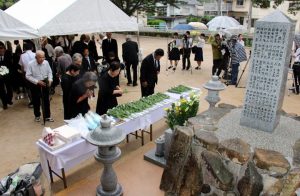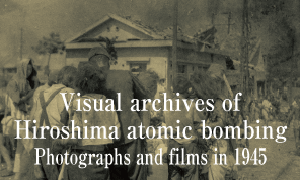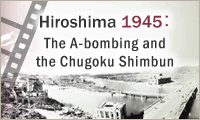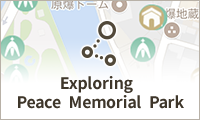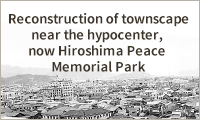Documenting Hiroshima 80 years after A-bombing: August 6, 2019, community affected by torrential rains, flooding in western Japan
May 31, 2025
To restore monument, local residents once again work together
by Michio Shimotaka, Staff Writer
On August 6, 2019, a memorial ceremony was held at Koyaura Park in the town of Saka-cho in Hiroshima Prefecture, one of the communities affected by the torrential rains and flooding that occurred in Western Japan the previous year, in 2018. In front of a memorial monument for victims of the atomic bombing that had been relocated and restored earlier in June that year by local residents, bereaved family members offered their prayers.
“I’m grateful we have a place to mourn the dead, because I had heard my aunt died with no one from her family by her side,” said Kinue Igawa, 57, a homemaker from Hiroshima City’s Naka Ward who was in attendance at the ceremony. With her aunt Masuko Kozakura’s name inscribed on the monument, Ms. Igawa had visited the monument every year together with her mother, Midori Shinya, 88, Masuko’s younger sister with whom Ms. Igawa now lives, until the torrential rains and flooding happened.
On August 6, 1945, when the U.S. military dropped the atomic bomb on Hiroshima, Masuko was a schoolgirl and experienced the atomic bombing while being mobilized for building-demolition work. She was taken to Ninoshima Island (in the city’s present-day Minami Ward) and died there, after which she is believed to have been buried in the area of Koyaura.
Midori, who was eight years old at the time of the bombing and had been evacuated to what is now Miyoshi City, has never forgotten her sister’s kindness. Masuko sent her beanbags filled with soybeans along with a message that said, “Whenever you get hungry, tear one open and eat the beans inside.” Midori added, “When my teacher used to scold me about my studies, she would step in and say to the teacher, ‘I’ll make sure I teach her later.’”
In the Koyaura district, those who experienced the atomic bombing, like Masuko, were transported and sheltered in schools and at seaside areas. Toshiki Nishitani, 79, a local resident, recalled, “I would hear from my mother, who had visited a local aid and relief center, about how there was a mix of groans, cries, and voices calling out for parents.” According to the Record of the Hiroshima A-bomb War Disaster, published in 1971, approximately 150 people were buried in the area.
Erecting grave marker, offering prayers
In 1946, local residents erected a wooden grave marker on that ground, replacing it whenever it would begin to decay from wind and rain and continuing their efforts to pay their respects to the dead. Despite that, a misconception persisted that the remains of the victims in Koyaura had been left exposed to the elements. Deeply saddened by the misunderstanding, local volunteers began an investigation in the 1980s into what really happened after the atomic bombing. As they searched for bereaved family members and carried out related activities, momentum grew for the construction of a memorial monument.
Fusao Tagawa, 84, a local landscaper from the area of Kaita-cho who was sympathetic to their cause, undertook the construction work free of charge in 1987, resulting in the creation of a memorial monument in the same location as the grave marker. “As someone from the generation who experienced the war, I wanted to do what little I could,” said Mr. Tagawa. The monument was made up of a 1.4-meter-high granite stone situated on a stone pedestal, and on its side were inscribed the names of 93 victims who had been identified through their own personal accounts before their deaths and from the name tags on their clothing.
Local residents had always looked after the monument, but on July 6, 2018, it was damaged when landslides from behind it were triggered by the torrential rains and flooding experienced in western Japan. In the Koyaura district, multiple landslides struck from the mountains surrounding the area. Large volumes of earth and debris swept into the area, resulting in the deaths of 15 people and leaving one person reported missing.
Association for preservation of monument formed
Around one week later, Ms. Igawa went to check on the monument. “I had given up because I thought it would simply be too difficult to maintain the monument,” she said. Just prior to the torrential rains and flooding, the Saka-cho Atomic Bomb Survivors Association had made the decision to disband the group at the end of July due to the aging of its members.
However, with the aim of restoring the monument, the residents once again sprang into action. Mr. Nishitani and others formed an association for preservation of the A-bomb memorial monument. The monument had originally been located at the base of a mountain, an inconvenient spot that required people to cross the train tracks of the JR Kure Line. With that, the association members contacted bereaved family members by letter and telephone seeking their opinions about relocation of the monument and negotiated with the town administrative office regarding potential sites. With funding from the town, the monument was successfully moved to Koyaura Park.
Mr. Nishitani regularly visits the monument for cleaning and other chores. “Eight out of 10 times, there is nothing for me to do. I suppose visitors to the park keep the monument clean and tidy.” Local elementary school students and elderly residents make offerings of folded paper cranes.
In conjunction with relocation of the monument, the landscaper Mr. Tagawa also brought soil from around the original monument in which he planted camellias. With permission, Ms. Igawa took some of the seeds home and planted them. This spring, they sprouted. She said, “My mother is now too old to visit the monument, so starting this year I’m thinking of having her make an offering of incense to a potted camellia.”
(Originally published on May 31, 2025)

